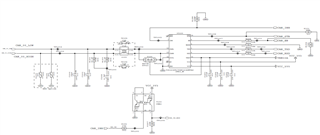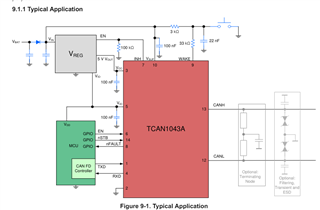Tool/software:
Hello Team,
We are using TCAN1043A-Q1 in our instrumentation cluster product. Using INH pin to enable the regulators on the board. Below is the schematics

Issue what we are facing is when the TRM30 (12V Battery) is connected to our Board very first time, Immediately INH is going HIGH which is as expected per datasheet making the product ON.
This we would like to avoid since this will create Board ON issue in vehicle assembly. So we tried making VCC(5V), VIO(3.3V) zero as suggested in datasheet to have undervoltage condition so that INH will be low.
But what we observed is INH is still continuously HIGH even after making VCC (5V), VIO (3.3V) zero . Below is the picture in the datasheet & we used same concept.
Question is --> We can see from the diagram that After INH goes HIGH only regulators will be turned ON. Then how it is monitoring VIO, VCC to achieve sleep mode ? Means INH we will set HIGH always irrespective of VCC, VIO right? Because VCC, VIO will be generated after INH enable.


Is there any other method to make INH low ? You can suggest some circuit. (From SW we tried making STB =LOW, EN = HIGH , This is making INH to go low perfectly)
Is there any IC with TI which gives INH "LOW" when VBAT is applied first time ?
Waiting for your valuable feedback.
Regards,
Shyamasundar Hegde

